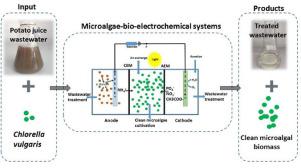Resources, Conservation and Recycling ( IF 11.2 ) Pub Date : 2021-01-27 , DOI: 10.1016/j.resconrec.2021.105441 Minmin Pan , Yanyan Su , Xinyu Zhu , Gang Pan , Yifeng Zhang , Irini Angelidaki

|
Chlorella vulgaris, one of the single cell protein sources, is a promising alternative to address the ever-growing demand for food-quality protein. Efforts have been made to overcome the high production costs by using wastewater for the cultivation of C. vulgaris. However, direct use of wastewater poses threats to the safety of applying the obtained biomass for food and animal feed. This study applied a novel three-chamber microalgal-bio-electrochemical systems for simultaneous clean cultivation of C. vulgaris and treatment of industrial organic wastewater. Results demonstrated that the removal of COD (38.7–66.8%) and total Kjeldahl nitrogen (TKN, 49.8–69.0%) improved with the increase of electric current in both anode and cathode chambers. Meanwhile, comparable phosphorus removal rates of 34.2–48.5% were achieved in all operation modes. Through nutrients migration, the middle chamber recovered 34.4–39.4% TKN, 16.8–47.3% phosphorus, and acetate from the wastewater to support a mixotrophic growth of C. vulgaris. Moreover, increasing electric current promoted higher dry algal biomass weight (0.87–1.11 g L−1), higher protein content (320.8–552.1 mg Protein g−1 Biomass), and larger cell size (enlarged up to 151.2%) than the control. Nevertheless, the ratio of protein content decreased with the increase of cell size due to the prior accumulation of other compounds under mixotrophic growth. This study provides a sustainable approach for the conversion from industrial organic wastewater to clean production of microalgal protein.
中文翻译:

生物电化学辅助工业有机废水的可持续转化和微藻蛋白的清洁生产
小球藻(Chlorella vulgaris)是一种单细胞蛋白质来源,是解决食品质量蛋白质不断增长的需求的有前途的替代品。通过使用废水来栽培普通梭菌已经做出努力来克服高生产成本。然而,废水的直接使用对将获得的生物质用于食品和动物饲料的安全性构成威胁。这项研究应用了一种新颖的三腔微藻生物电化学系统s用于同时清洁栽培小球藻和处理工业有机废水。结果表明,随着阳极室和阴极室中电流的增加,COD(38.7–66.8%)和总凯氏氮(TKN,49.8–69.0%)的去除得以改善。同时,在所有运行模式下,除磷率均达到34.2–48.5%。通过营养物质的迁移,中室从废水中回收了34.4–39.4%的TKN,16.8–47.3%的磷和乙酸盐,以支持寻常梭菌的混养。此外,电流的增加促进了干藻生物量的增加(0.87–1.11 g L -1),蛋白质含量更高(320.8–552.1 mg蛋白质g -1)生物质)和比对照组更大的细胞大小(最大可放大151.2%)。然而,由于混合营养生长下其他化合物的预先积累,蛋白质含量的比率随着细胞大小的增加而降低。该研究为从工业有机废水转化为微藻蛋白的清洁生产提供了一种可持续的方法。











































 京公网安备 11010802027423号
京公网安备 11010802027423号